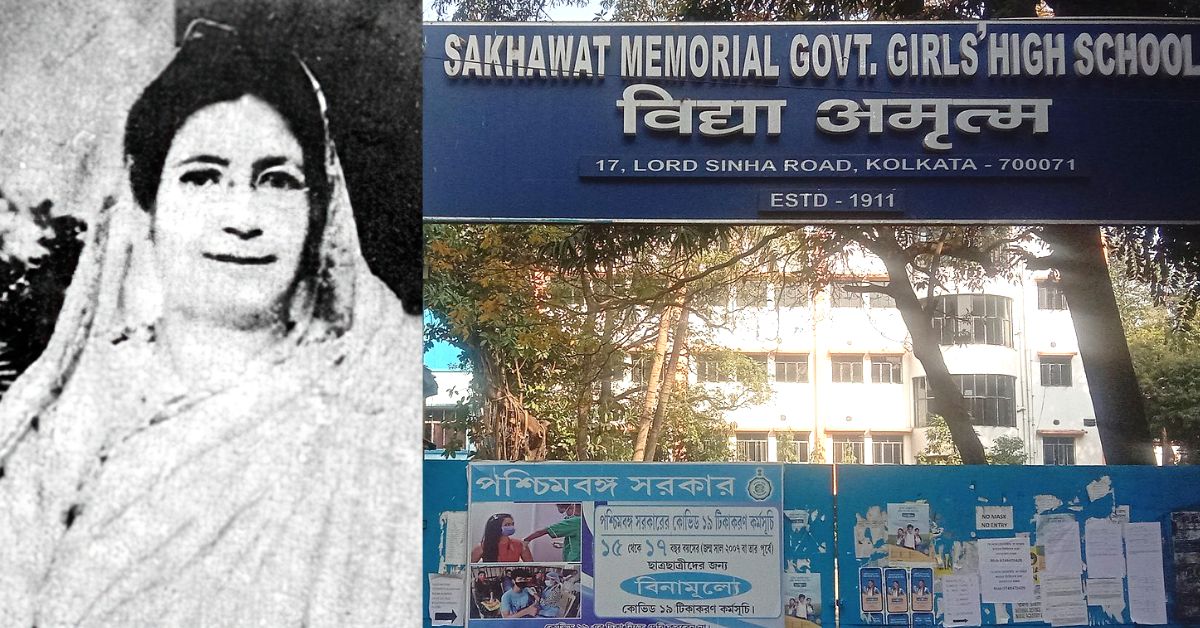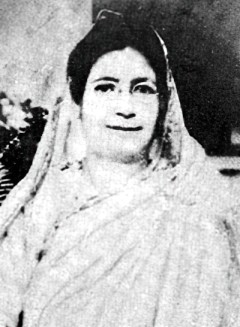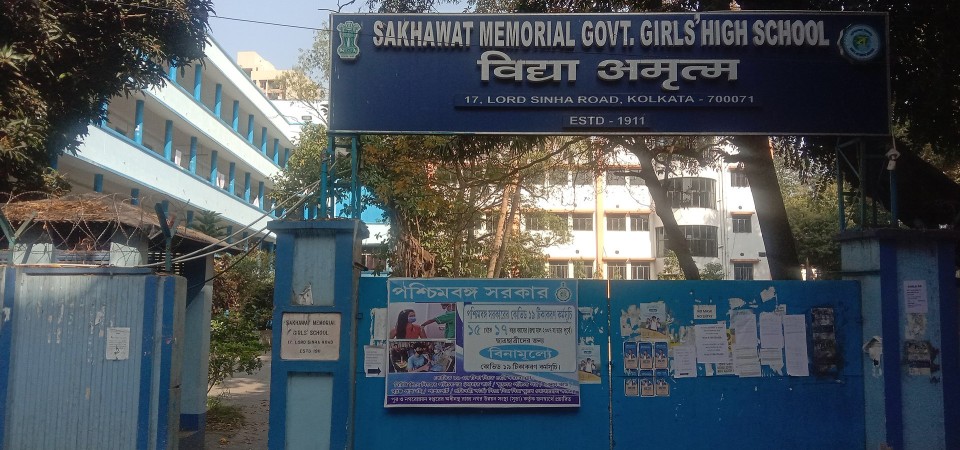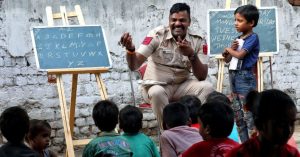Denied Education, She Went Door to Door to Build India’s 1st School for Muslim Girls
Rokeya Sakhawat Hossain, or Begum Rokeya, fought grave opposition and criticism to build India’s first school for Muslim girls. She goes down in history as being key in launching Bengal’s feminist revolution.

Year: 1905
Location: Ladyland
They say this is a ‘feminist utopia’, where the purdah system has been reversed. Here, the men are confined indoors, and the women roam the world freely, having just stopped a war with nonviolent tactics and restored health and progress across nations.
“You need not be afraid of coming across a man here. This is Ladyland, free from sin and harm. Virtue itself reigns here.”
Science has progressed enough that there is an abundance of labourless farming and flying cars. Scientists, naturally women, have discovered how to trap solar power and control the weather. There is no crime, the only religion is truth and love, and ideals of peace and co-existence overpower aggression and violence.
In her book, Sultana’s Dream (1905) Rokeya Sakhawat Hossain created ‘Ladyland’ to offer an alternate reality — what if men were made to live like women?
The proto-science fiction story would become the Bengali activist and educator’s most prominent piece of work. And yet, it was only a glimpse of Rokeya’s belief that women — particularly Muslims — living in colonial India deserved more than the destinies mapped out for them.
Known popularly as Begum Rokeya, the feminist thinker drew from her own experiences of growing up in a conservative household, where her brothers were encouraged to pursue Western education, while she was held back by virtue of being a girl.

Where women are visible once again
Rokeya was born to a Bengali Muslim family in Rangpur in the erstwhile Bengal Presidency in 1880. Her well-to-do family strictly observed the purdah system — a custom that segregated the sexes and asked women to remain under full cover to hide their skin and form.
Rokeya was asked to only learn Urdu to be able to interpret the Quran because it was thought that learning Bangla or English would drive women towards unfamiliar cultures and the “loose morals” of the West. But with her sister Karimunnessa, Rokeya secretly learned how to read and write the languages.
Local accounts state that luck would never be on Karimunnessa’s side — to curb her thirst for knowledge and literature, she was married at the tender age of 14. Rokeya was reportedly left deeply impacted by this sudden end to her sister’s dreams for her future, and this would begin to shape her feminist ideals.
When Rokeya turned 18, she was married to Khan Bahadur Sakhawat Hossain, a man much senior to her in age, almost in his 40s at the time. But Khan encouraged young Rokeya to pursue her love for education and literature unbridled. It was on his advice that she adapted Bengali as the primary language in all her later works.

Rokeya’s literary career launched with a Bengali essay titled Pipasa (thirst) in the year 1902, followed by a book named Matichur in 1905.
The same year, she wrote her most popular work Sultana’s Dream, with herself — reimagined as a woman named Sultana — at the forefront.
In the book, Sultana falls asleep while “thinking lazily of the condition of Indian womanhood”, and awakens to encounter a scientist name Sister Sara, who takes her around a feminist utopia where women dominate science, history, and politics, a vision far from the reality that Sultana is used to.
In the book, one ‘Lady Principal’ heads an all-women university. Before the revolution, her scientific research was deemed “a sentimental nightmare” by men for placing more importance on social welfare than “enhancing the state’s military power”.
This was, perhaps, inspired by what Rokeya observed in the real world, writes Lady Science.
“During the colonial period, voyaging scientists harnessed imperial expansion to their stores of scientific knowledge, collectively imposing European dominion over the rest of the world. The invention of clocks, telescopes, and telegraph machines were, in part, driven by the need to navigate, observe, and communicate during wartime as much as any civilian or scientific need; the legacy of the atomic bomb continues to dominate geopolitics today. Around the world, military budgets continue to surge, while many nation’s civilian science budgets stagnate.”
In 1905, Begum Rokheya Sakhawat Hossain envisioned a world built by women using science and technology to make daily life more pleasurable and peaceful.
This Women’s Day, we look to *Sultana’s Dream* as a reminder of how far we’ve come and how much further we need to go. pic.twitter.com/0Eo6oP60HI— Tara Books (@TaraBooks) March 8, 2022
Meanwhile, Muslim women in colonial India were “rendered invisible”, wrote historical sociologist Mahua Sarkar. This was a group erased from the national discourse of nationalism and colonial rule in India, and was either confined to notions of “a backward, depraved, minority community” or “ignored altogether”.
Project Myopia, an online publication that works for historic inclusivity in academia and curricula, wrote that Rokeya’s work was written at a time when girls’ education was limited in Bengal, “mostly restricted to domestic vocations or specific religious branches”.
For Rokeya, the education of Muslim women was the key to their liberation.
When her husband passed away suddenly in 1909, this belief would lead her to establish India’s first school for Muslim girls in his name — Sakhawat Memorial Girls’ High School in Bagalpur. For this, she used the Rs 10,000 he had left for her, and the rest she collected from her own resources.
It is said that she went door to door to recruit young girls from families unwilling to let their daughters be educated. Most parents had the condition that the purdah would be strictly maintained, to which Rokeya obliged.
The school officially started in 1911 with eight students — a number that slowly increased with time. To keep her promise to parents, the activist arranged horse carriages to ferry the girls to and from school so as to maintain the purdah.
Rokeya ran the school, which later shifted to Calcutta (now Kolkata) for 24 years, despite strong opposition from the local community. The girls learnt lessons in Bangla, English, Urdu, and Persian, as well as activities like physical education, music, cooking, first aid, nursing, and more. Rokeya personally oversaw all the workings of the school and took an active part in training teachers.
Over a century later, the school continues to run, managed by the state government.

Where is ‘Ladyland’ today?
Rokeya also established the Anjuman-e-Khawateen-e-Islam, or the Islamic Women’s Association, to hold debates and conferences to discuss the status of women’s education.
Meanwhile, her later literary work would continue uploading her belief in women’s education.
In Padmarag (1924), she told the story of the all-women staff at Tharini Bhavan, a women’s boarding house and school. The institution “was revolutionary in its secular approach to education, aimed at providing equal opportunities for local girls regardless of class, religion or caste”. Meanwhile, Abarodbhasini, or The Confined Women (1931), wrote about how the purdah damaged the lives and self-esteem of women.
Rokeya also believed that education was not only a way out of oppression, but also the key to destabilising colonial rule, religious extremism, and casteism.
“Whenever any woman tries to raise her head, weapons in the form of religions or holy scriptures strike her head…Men propagate those scriptures as God’s commandments to subdue us in darkness…Those scriptures are nothing but systems constructed by men. The words we [hear] from male saints would be different if they were spoken by female saints. … Religions only tighten the yoke of servitude around women and justify male domination over women,” she once said.
She passed away in 1932, much before the creation of Pakistan and Bangladesh. The latter marks every 9 December as ‘Rokeya Day’, and she is widely regarded as the one who catapulted a feminist revolution in undivided Bengal. Universities stand in her name and awards titled after her are handed to women who show exceptional achievements.

In the 21st century, ‘Sultana’s dream’ may seem like a vision that’s still too far away. Afterall, Muslim women continue to face gross exclusion from housing, employment, and education in India.
But look closely and you’ll find little corners where her dream manifests — women are fighting for their rightful place in education, science, and politics. So maybe slowly, we inch towards our own version of ‘Ladyland’.
Edited by Yoshita Rao
Sources:
Hossain, B. R. S. (2005). Sultana’s Dream. India: Tara.
Majumdar, R. (2009). Processes That Rendered Muslim Women Invisible [Review of Visible Histories, Disappearing Women: Producing Muslim Womanhood in Late Colonial Bengal, by M. Sarkar]. Economic and Political Weekly
Feminist Visions of Science and Utopia in Rokeya Sakhawat Hossain’s ‘Sultana Dream’: Published by Lady Science, 2019
Sultana’s Dream and Padmarag (Essence of the Lotus) by Rokeya Shakhawat Hossain: Written by Ibtisam Ahmed for Project Myopia
The Manless World of Rokeya Sakhawat Hossain: Written by Rafia Zakaria for Dawn, Published on 13 December 2013
Sultana’s Dream: The Brilliant Vision of Rokeya Sakhawat Hossain: Written by Joshua Glenn for The Wire Science, Published on 3 April 2022
If you found our stories insightful, informative, or even just enjoyable, we invite you to consider making a voluntary payment to support the work we do at The Better India. Your contribution helps us continue producing quality content that educates, inspires, and drives positive change.
Choose one of the payment options below for your contribution-
By paying for the stories you value, you directly contribute to sustaining our efforts focused on making a difference in the world. Together, let's ensure that impactful stories continue to be told and shared, enriching lives and communities alike.
Thank you for your support. Here are some frequently asked questions you might find helpful to know why you are contributing?


This story made me
-
97
-
121
-
89
-
167

















